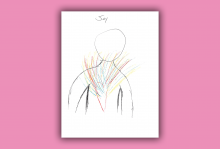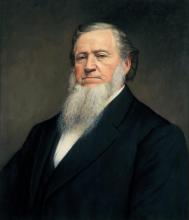BYU

IT'S LONG BEEN known that empathy may be inherent in portraiture—walking a mile in the shoes of one’s painting subject. As the renowned 15th-century painter and monk Fra Angelico put it, “He who wishes to paint Christ’s story must live with Christ.” New research reinforces this association between artmaking and spirituality.
A 2020 Fetzer Institute study of U.S. spirituality, which includes 16 focus groups and 26 in-depth interviews, reports that more than 80 percent of its 3,600 respondents self-identified as somewhat spiritual, and about 60 percent aspired to be more spiritual. Novelly, researchers used drawings as an “inductive research tool” to understand better what respondents meant by “spirituality,” said Veronica Selzler, lead author of the Fetzer study and strategy director at Hattaway Communications in Washington, D.C. Art allowed participants to define spirituality creatively rather than prescriptively. “It was through these drawings that the diversity and common threads began to emerge,” she said.
The study reproduced 38 drawings in which respondents, aged 18 to 71, interpreted spirituality. The “slightly spiritual/not religious at all” Dale, 69, drew five clouds—one perhaps smiling—and grass as his “happy place, but you could call it a spiritual place.” Daniel, 20, who is “very spiritual/not at all religious,” drew a self-portrait praying on his knees before Jesus.

If they were alive today, nearly half the presidents of the Church of Jesus Christ of Latter-day Saints — from Brigham Young in the 19th century through George Albert Smith in the 1940s — would be forbidden from serving in the faith’s 141 temples worldwide.
That’s because being clean-shaven is generally a requirement for men to be Mormon temple workers. Whiskers are fine for temple-going members, but even nicely trimmed beards and mustaches are no-nos for temple workers.
“It is ironic that temple workers are expected to be more clean-shaven than the deity figures — God and Jesus Christ — portrayed in LDS films and portraits,” says Armand Mauss, a leading Mormon sociologist in Irvine, Calif.

Caffeine-craving students at Brigham Young University are pushing the Mormon-owned school to change its stance on cola drinks.
The move was triggered by Aug. 30 statements from BYU spokeswoman Carri Jenkins in which she said that the school doesn’t serve or sell caffeinated drinks because there has not “been a demand for it.”
The ban on caffeinated sodas is “not a university or church decision,” Jenkins told The Salt Lake Tribune then, one day after the Church of Jesus Christ of Latter-day Saints posted a statement on its website saying that “the church does not prohibit the use of caffeine," only "hot drinks" like tea and coffee.
BYU's dining services does conduct “online surveys, focus groups and data analysis” to determine what items to offer on campus, BYU’s The Universe student newspaper reported, but “has not asked about caffeinated soft drinks.”
“I have received emails on both sides of the issue — those in favor of caffeine and those against it,” Dean Wright, director of dining services, told the student paper. “Dining Services is so busy just getting everything open and serving over 30,000 meals a day that we do not have any plans at this point to do any polling on caffeine.”
For some Mormon feminists, there can be only one goal on the road to gender equality: ordination to the all-male priesthood.
After all, every worthy male in the Church of Jesus Christ of Latter-day Saints — starting at age 12 — is ordained in this priesthood. It is seen as a holy power, described as the authority to act in God’s name, yet given exclusively to men.
At the same time, lots of Mormon women are perfectly comfortable with the roles they believe God assigned to them, including motherhood and nurturing. They would not want, they say, to “hold the priesthood.”
Now comes a third and, some suggest, growing group of Mormon women somewhere between these two poles.
They are not pushing for ordination, but they crave a more engaged and visible role for women in the Mormon church. It is a role, they believe, that their Mormon foremothers played — and one that could fit easily into the institutional structure without distorting or dismantling doctrine.